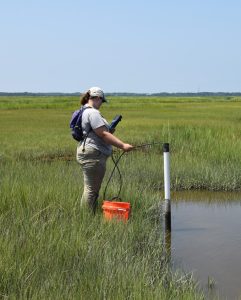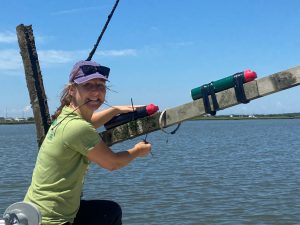by Dr. Lenore Tedesco, Executive Director
 Wetlands and coastal ecosystems are incredibly dynamic and change is constant. Superimposed on their rhythmic changes are increased pressures related to climate change, sea level rise, and intensifying human use of these resources. The Wetlands Institute is exceptionally well-positioned to expand its work to study the changes that are occurring and what they mean to the wildlife in the systems, and is acting to restore and conserve them.
Wetlands and coastal ecosystems are incredibly dynamic and change is constant. Superimposed on their rhythmic changes are increased pressures related to climate change, sea level rise, and intensifying human use of these resources. The Wetlands Institute is exceptionally well-positioned to expand its work to study the changes that are occurring and what they mean to the wildlife in the systems, and is acting to restore and conserve them.
Our work over the past several years has also been increasingly focused on studying the responses of marshes and wildlife to marsh restoration and habitat creation projects. As a part of this work, we recently launched the Coastal Sustainability and Wetland Health Research Program. Thanks to generous grants from The Wiseman Family Foundation, The Davenport Family Foundation, The Leff Family Foundation, The Ward Family Foundation, Disney Conservation Fund, the NJ Corporate Wetlands Restoration Partnership, State of NJ DEP, and US Army Corps of Engineers, our scientists have been incredibly busy being the eyes and ears of these marshes. We maintain a comprehensive network of monitoring programs that, along with our partners, are tracking theses ecosystems.
In 2016, we installed wetland elevation monitoring stations that allow for precision measurement of the marsh surface, and we are monitoring both elevation and marsh vegetation at TWI and at project sites where habitat has been created using clean dredged materials. We have established an array of water chemistry monitoring stations at The Wetlands Institute, in surrounding marshes, and at beneficial use restoration sites for comparison. They are paired with eight stations that continuously measure water elevation. Wetland plants are very sensitive to water depth and maintain maximum growth potential over a very narrow range. These stations enable researchers to understand how the marsh is responding to increased flooding under accelerating sea level rise. We are able to understand how marsh grasses are reestablishing at restoration sites and how rising seas are changing the delicate balance, using the data we gather to inform restoration projects.
Information about how wildlife is using these marshes and how increased flooding is affecting them is another crucial aspect of the research. We have enhanced our monitoring with surveys of saltmarsh-dependent animals to document how sea-level rise and coastal flooding are impacting local populations, and how they are responding to habitat restoration and creation. The health of coastal bird and diamondback terrapin populations is intricately linked to the condition of coastal marsh systems. Changes in the number of animals in the marsh, how they are using the marsh, and their breeding success can indicate changes within the saltmarsh itself. Several species of birds nest just above the marsh surface and nest loss due to flooding has become a new reality. Are these birds moving to new areas, changing their nesting practices, or utilizing newly created habitats? American Oystercatchers, which nest on area beaches as well as in the marsh, are of special interest. Our trained staff band Oystercatchers to better monitor the local population and habitat use. Clapper Rails, Willets, Laughing Gulls, and Saltmarsh Sparrows are also species of interest and the subject of various monitoring programs. How is repetitive marsh flooding affecting diamondback terrapins? They seek nesting areas above the high tide line, yet their nests are being more frequently flooded. Is the flooding affecting hatchling terrapins that spend their early years in the marshes?
The Wetlands Institute has collected volumes of information over the years and new work continues to build these important data sets. Partnerships borne out of the Seven Mile Island Innovation Laboratory continue to expand the work being done in these marshes. Scientists from University of Pennsylvania, Louisiana State University, Villanova, Boston College, Stockton University, Widener University, and the US Army Corps of Engineers are collaborating and conducting additional research here.
 Our research scientists are using newly acquired information to better understand marsh usage by sensitive species, and everyone at the Institute is working to preserve and protect our treasured marsh resources. We are providing decision-makers with information about marsh conditions and how to restore them so they can play their critical role in coastal sustainability and storm protection for our community. Our efforts are helping guide management and coastal restoration decisions. These are complex systems and we are working to make sure these marshes are here for generations to come.
Our research scientists are using newly acquired information to better understand marsh usage by sensitive species, and everyone at the Institute is working to preserve and protect our treasured marsh resources. We are providing decision-makers with information about marsh conditions and how to restore them so they can play their critical role in coastal sustainability and storm protection for our community. Our efforts are helping guide management and coastal restoration decisions. These are complex systems and we are working to make sure these marshes are here for generations to come.
